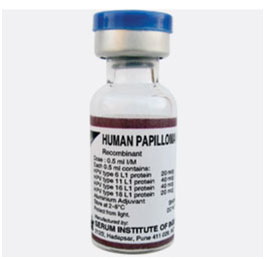
Image courtesy: Serum institute of India
CERVAVAC is termed as a quadrivalent HPV Vaccine. The mechanism of action of a quadrivalent human papillomavirus vaccination is to elicit an immunological response to four distinct antigens. India’s first locally produced vaccine against cervical cancer is called CERVAVAC, and it was created by the Serum Institute of India (SII).
How do HPV vaccines work? What are they, and how do you understand them?
Human papillomavirus (HPV) vaccinations guard against infection brought on by this group of more than 200 closely related viruses. More than 40 of diseases are transferred via intimate contact. Genital warts can be brought on by as many as two HPV kinds, and roughly a dozen HPV types can bring on cervical, oropharyngeal, vulvar, vaginal, penile, and anal malignancies, to name just a few.
The National Cancer Institute of the US National Institute of Health (NIH) reports that three vaccines are currently being offered in numerous nations all over the world to prevent infection with the disease-causing HPV. These include Cervarix, Gardasil, and Gardasil 9.
The vaccines Cervarix is bivalent, Gardasil 9 is nonavalent, and Gardasil is quadrivalent. This translates to four, nine, and two HPV strains in Gardasil, Gardasil 9, and Cervarix, respectively.
HPV types 6, 11, 16, and 18 are prevented by Gardasil, while HPV types 16 and 18 are prevented by Cervarix.
Infection with HPV types 6, 11, 16, 18, 31, 33, 45, 52, and 58 is prevented with Gardasil 9.
HPV types 16 and 18 are thought to be the main causes of about 70% of cervical malignancies.
The high-risk HPV strains 31, 33, 45, 52, and 58 are responsible for an additional 10% to 20% of cervical cancer cases.
How Does the HPV Vaccine (CERVAVAC) Prevent Cervical Cancer Work?
Tetravalent or quadrivalent L1 virus-like particles (VLPs) of serotypes 6, 11, 16, and 18 are part of the SII’s HPV vaccination. An immune response is elicited against four distinct antigens, such as four distinct viruses or other microbes, using a quadrivalent vaccine. For instance, the quadrivalent vaccine Gardasil shields the body from four different forms of HPV infection. The nine-drug Gardasil 9 vaccine, meanwhile, offers defence against HPV types 6, 11, 16, 18, 31, 33, 45, 52, and 58.
To create virus-like particles, which are molecules that resemble viruses but are not contagious, the L1 protein is sufficient. These particles are a useful method for developing vaccinations against illnesses brought on by the hepatitis B virus and various HPVs, among others.
What the WHO Says About the HPV Vaccines?
The World Health Organization (WHO) claims that a single dosage of the HPV vaccine offers effective protection against the human papillomavirus.
According to a statement issued by the UN health agency, Dr. Alejandro Cravioto, Chair of the WHO Strategic Advisory Group of Experts on Immunization (SAGE), claimed the HPV vaccine is extremely efficient for the prevention of HPV serotypes 16 and 18, which are responsible for 70% of cervical cancer.
SAGE suggests giving the HPV vaccine in one or two doses to children between the ages of nine and fourteen, one or two doses to young women between the ages of 15 and twenty, and two doses spaced six months apart to women over the age of 21.
